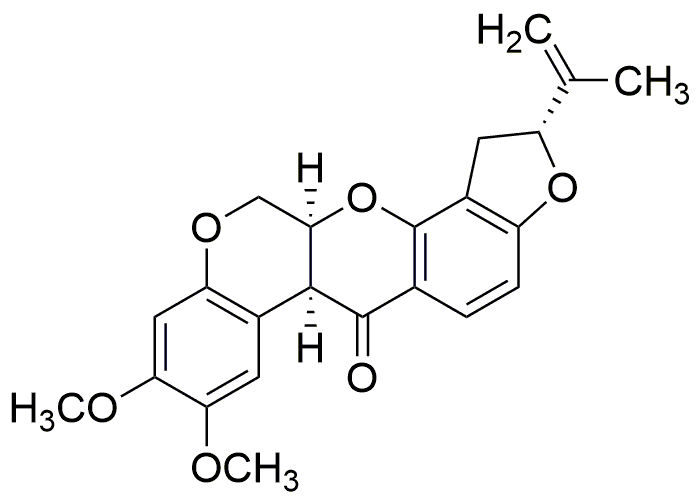Rotenone is widely utilized in research focused on:
- Agricultural Pest Control: Commonly used as a natural insecticide, it effectively targets a variety of pests in organic farming, providing an eco-friendly alternative to synthetic chemicals.
- Fisheries Management: Employed to manage fish populations, rotenone is used to remove unwanted species from water bodies, helping to restore ecological balance.
- Neuroscience Research: In laboratory settings, it serves as a tool to induce Parkinsonian symptoms in animal models, aiding in the study of neurodegenerative diseases.
- Biological Research: Utilized in studies of cellular respiration, it inhibits mitochondrial function, allowing researchers to explore metabolic pathways and energy production.
- Natural Product Chemistry: Rotenone is a key compound for extracting and studying other natural products, facilitating the development of new pharmaceuticals and bioactive compounds.
General Information
Properties
Safety and Regulations
Applications
Rotenone is widely utilized in research focused on:
- Agricultural Pest Control: Commonly used as a natural insecticide, it effectively targets a variety of pests in organic farming, providing an eco-friendly alternative to synthetic chemicals.
- Fisheries Management: Employed to manage fish populations, rotenone is used to remove unwanted species from water bodies, helping to restore ecological balance.
- Neuroscience Research: In laboratory settings, it serves as a tool to induce Parkinsonian symptoms in animal models, aiding in the study of neurodegenerative diseases.
- Biological Research: Utilized in studies of cellular respiration, it inhibits mitochondrial function, allowing researchers to explore metabolic pathways and energy production.
- Natural Product Chemistry: Rotenone is a key compound for extracting and studying other natural products, facilitating the development of new pharmaceuticals and bioactive compounds.
Documents
Safety Data Sheets (SDS)
The SDS provides comprehensive safety information on handling, storage, and disposal of the product.
Product Specification (PS)
The PS provides a comprehensive breakdown of the product’s properties, including chemical composition, physical state, purity, and storage requirements. It also details acceptable quality ranges and the product's intended applications.
Certificates of Analysis (COA)
Search for Certificates of Analysis (COA) by entering the products Lot Number. Lot and Batch Numbers can be found on a product’s label following the words ‘Lot’ or ‘Batch’.
*Catalog Number
*Lot Number
Certificates Of Origin (COO)
This COO confirms the country where the product was manufactured, and also details the materials and components used in it and whether it is derived from natural, synthetic, or other specific sources. This certificate may be required for customs, trade, and regulatory compliance.
*Catalog Number
*Lot Number
Safety Data Sheets (SDS)
The SDS provides comprehensive safety information on handling, storage, and disposal of the product.
DownloadProduct Specification (PS)
The PS provides a comprehensive breakdown of the product’s properties, including chemical composition, physical state, purity, and storage requirements. It also details acceptable quality ranges and the product's intended applications.
DownloadCertificates of Analysis (COA)
Search for Certificates of Analysis (COA) by entering the products Lot Number. Lot and Batch Numbers can be found on a product’s label following the words ‘Lot’ or ‘Batch’.
*Catalog Number
*Lot Number
Certificates Of Origin (COO)
This COO confirms the country where the product was manufactured, and also details the materials and components used in it and whether it is derived from natural, synthetic, or other specific sources. This certificate may be required for customs, trade, and regulatory compliance.


